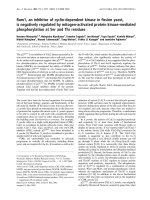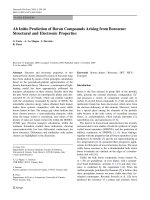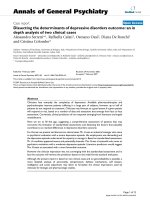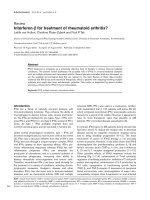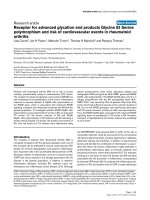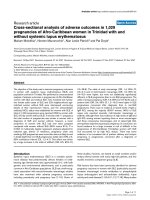Báo cáo y học: "Prohormones for prediction of adverse medical outcome in community-acquired pneumonia and lower respiratory tract infections"
Bạn đang xem bản rút gọn của tài liệu. Xem và tải ngay bản đầy đủ của tài liệu tại đây (1.12 MB, 14 trang )
Schuetz et al. Critical Care 2010, 14:R106
/>Open Access
RESEARCH
© 2010 Schuetz et al.; licensee BioMed Central Ltd This is an open access article distributed under the terms of the Creative Commons
Attribution License ( which permits unrestricted use, distribution, and reproduction in
any medium, provided the original work is properly cited.
Research
Prohormones for prediction of adverse medical
outcome in community-acquired pneumonia and
lower respiratory tract infections
Philipp Schuetz
†1
, Marcel Wolbers
†2,3
, Mirjam Christ-Crain
1
, Robert Thomann
1,4
, Claudine Falconnier
1,5
,
Isabelle Widmer
6
, Stefanie Neidert
6
, Thomas Fricker
7
, Claudine Blum
8
, Ursula Schild
1
, Nils G Morgenthaler
9
,
Ronald Schoenenberger
4
, Christoph Henzen
6
, Thomas Bregenzer
8
, Claus Hoess
7
, Martin Krause
7
, Heiner C Bucher
2
,
Werner Zimmerli
5
, Beat Mueller*
8
for the ProHOSP Study Group
Abstract
Introduction: Measurement of prohormones representing different pathophysiological pathways could enhance risk
stratification in patients with community-acquired pneumonia (CAP) and other lower respiratory tract infections (LRTI).
Methods: We assessed clinical parameters and five biomarkers, the precursor levels of adrenomedullin (ADM),
endothelin-1 (ET1), atrial-natriuretic peptide (ANP), anti-diuretic hormone (copeptin), and procalcitonin in patients with
LRTI and CAP enrolled in the multicenter ProHOSP study. We compared the prognostic accuracy of these biomarkers
with the pneumonia severity index (PSI) and CURB65 (Confusion, Urea, Respiratory rate, Blood pressure, Age 65) score
to predict serious complications defined as death, ICU admission and disease-specific complications using receiver
operating curves (ROC) and reclassification methods.
Results: During the 30 days of follow-up, 134 serious complications occurred in 925 (14.5%) patients with CAP. Both PSI
and CURB65 overestimated the observed mortality (X
2
goodness of fit test: P = 0.003 and 0.01). ProADM or proET1
alone had stronger discriminatory powers than the PSI or CURB65 score or any of either score components to predict
serious complications. Adding proADM alone (or all five biomarkers jointly) to the PSI and CURB65 scores, significantly
increased the area under the curve (AUC) for PSI from 0.69 to 0.75, and for CURB65 from 0.66 to 0.73 (P < 0.001, for both
scores). Reclassification methods also established highly significant improvement (P < 0.001) for models with
biomarkers if clinical covariates were more flexibly adjusted for. The developed prediction models with biomarkers
extrapolated well if evaluated in 434 patients with non-CAP LRTIs.
Conclusions: Five biomarkers from distinct biologic pathways were strong and specific predictors for short-term
adverse outcome and improved clinical risk scores in CAP and non-pneumonic LRTI. Intervention studies are warranted
to show whether an improved risk prognostication with biomarkers translates into a better clinical management and
superior allocation of health care resources.
Trial Registration : NCT00350987.
Introduction
The assessment of disease severity and prediction of out-
come in lower respiratory tract infections (LRTI) and, in
particular, community-acquired pneumonia (CAP), is
essential for the appropriate allocation of health care
resources and for optimized treatment decisions. These
include hospital or intensive care unit admission, the
extent of diagnostic work-up, the choice and route of
antimicrobial agents and the evaluation for early dis-
charge. In an attempt to optimize and lower unnecessary
hospital admission rates, professional organizations have
developed prediction rules and propagated guidelines to
* Correspondence:
8
Department of Internal Medicine, Kantonsspital Aarau, Tellstrasse, 5000 Aarau,
Switzerland
†
Contributed equally
Full list of author information is available at the end of the article
Schuetz et al. Critical Care 2010, 14:R106
/>Page 2 of 14
stratify patients with CAP based on predicted risks for
mortality [1-3]. The pneumonia severity index (PSI) is a
well validated scoring system in North America based on
19 prognostic parameters [4]. The CURB65 score, a more
simplified assessment tool developed by the British Tho-
racic Society, focuses on only five predictors [5,6]. This
score is easier to calculate, but has a lower prognostic
accuracy. Both risk scores were validated for the predic-
tion of mortality only. Their ability to predict other
important adverse disease outcomes including the need
for ICU admission and complications due to the infection
has not been established. Patients with PSI risk classes 1,
2 and 3 should be considered as candidates for outpatient
treatment, but still a high percentage of subjects in these
risk classes may experience unexpected complications
indicating the need for improvement of these scores [7].
To improve the accuracy of clinical severity scores, pro-
hormones have been proposed as biomarkers that pro-
vide more detailed and complementary information [8-
25]. Several biomarkers have been related to disease
severity and outcome in LRTI and sepsis, including levels
of the cardiac hormone atrial-natriuretic peptide (ANP)
[13-17], the stress- and volume-dependent antidiuretic
hormone (ADH, vasopressin) [21-25], the endothelium
derived hormones endothelin-1 (ET-1) [11,18-20] and
adrenomedullin (ADM) [8-12], and procalcitonin (PCT)
a specific marker of bacterial infections [26-35].
The simultaneous measurement of a panel of prohor-
mones each reflecting a specific pathophysiological path-
way could enhance risk stratification in patients with
CAP and other LRTI. We therefore validated the useful-
ness of five previously reported prohormones for predict-
ing serious complications in patients with CAP and other
LRTI enrolled in the multicenter ProHOSP study [31,34].
Materials and methods
Study sample
We measured biomarker levels in all patients with LRTIs
enrolled in the multicenter ProHOSP study [31]. The
design of the ProHOSP study has been reported in detail
elsewhere [34]. In brief, from October 2006 to March
2008, a total of 1,359 consecutive patients with presumed
LRTIs from six different hospitals located in the northern
part of Switzerland were included. Patients were ran-
domly assigned to an intervention group, where guidance
of antibiotic therapy was based on PCT cut off ranges or
to a standard group where guidance of antibiotic therapy
was based on enforced guideline recommendations with-
out knowledge of PCT. The primary end-point in this
non-inferiority trial was a combined endpoint of adverse
medical outcomes within 30 days following the ED
admission. A further predefined secondary objective was
the evaluation of different biomarkers to predict serious
complications and all causes of mortality as compared to
established risk factors and clinical scores.
The study protocol was approved by all local ethical
committees, and written informed consent for the collec-
tion of blood on admission and during follow-up to mea-
sure biomarkers was obtained from all participants.
Definition of different LRTIs and severity assessment
We used web-based guidelines for a standardized care of
patients as defined previously [34]. Thereby, LRTI was
defined by the presence of at least one respiratory symp-
tom (cough, sputum production, dyspnea, tachypnea,
pleuritic pain) plus at least one finding during ausculta-
tion (rales, crepitation), or one sign of infection (core
body temperature >38.0°C, shivering, leukocyte count
>10 G/l or <4 G/l cells) independent of antibiotic pre-
treatment. CAP was defined as a new infiltrate on chest
radiograph [1,2,36,37]. Chronic obstructive pulmonary
disease (COPD) was defined by post-bronchodilator
spirometric criteria according to the Global initiative for
chronic Obstructive Lung Disease (GOLD)-guidelines as
a FEV1/FVC ratio below 70% [36,38]. Acute bronchitis
was defined as LRTI in the absence of an underlying lung
disease or focal chest signs and infiltrates on chest x-ray,
respectively [37]. The Pneumonia Severity Index (PSI)
and the CURB65 scores were calculated in all patients as
described on admission to the emergency department
[4,6]. Our web-based guidelines provided published crite-
ria for ICU admission based on the 2001 American Tho-
racic Society (ATS) criteria [1]. In brief, ICU admission
should be considered in patients with severe CAP,
defined as the presence of either one of two major criteria
(need for mechanical ventilation, septic shock), the pres-
ence of two of three minor criteria (systolic blood pres-
sure <90 mmHg, multilobar disease, PaO2/FIO2ratio
<250) or more than two CURB points. For COPD
patients, ICU criteria included severe acidosis or respira-
tory failure (pO2 <6.7 kPa, pCO2 >9.3 kPa, pH <7.3), no
response to initial treatment in the emergency depart-
ment or worsening mental status (confusion, coma)
despite adequate therapy.
Analysis population, endpoints and covariates
The primary analysis population contains all 925 patients
with the final diagnosis of CAP. In a second step, perfor-
mance of developed models was extrapolated to patients
with non-CAP LRTI (that is, acute bronchitis and exacer-
bation of COPD).
The primary endpoint of this prognostic study was seri-
ous complications defined as death from any cause, ICU
admission, or disease specific complications defined as
local or systemic complications from LRTI including per-
sistence or development of pneumonia (including noso-
comial), lung abscess, empyema or acute respiratory
Schuetz et al. Critical Care 2010, 14:R106
/>Page 3 of 14
distress syndrome within 30 days following inclusion.
The secondary endpoint was overall survival within 30
days following study inclusion. Outcomes were assessed
during hospital stay at days 3, 5, 7, at hospital discharge,
and by structured phone interviews after 30 days by
blinded medical students and adjudicated by an indepen-
dent data-monitoring committee [31,34].
Pre-defined covariates for the prognostic models were
the covariates included in the CURB65 score (all covari-
ates except for confusion as continuous variables) and the
five prohormones. Prohormone levels and urea were log-
transformed prior to all analyses to normalize their distri-
bution. In exploratory analysis we also explored all cova-
riates included in the PSI score.
Biomarker selection and measurement
We selected five prohormones because of reported asso-
ciations with death or serious complications, biologic
plausibility and availability [8-25]. We measured PCT and
proADM as markers of bacterial infection and inflamma-
tion; the atrial-natriuretic peptide proANP and proET-1
as markers of cardiac and endothelial function, and the
vasopressin precursor copeptin as a marker of stress and
fluid balance. ProADM, proET-1, proANP and copeptin
were batch-measured in plasma with new sandwich
immunoassay as described elsewhere [8,25,39-41]. The
assays have analytical detection limits of 0.08 nmol/L, 0.4
pmol/L, 4.3 pmol/L and 0.4 pmol/L, respectively. PCT
was measured with a high sensitive time-resolved ampli-
fied cryptate emission (TRACE) technology assay (PCT
Kryptor
®
, B.R.A.H.M.S. AG, Hennigsdorf, Germany). The
assay has a detection limit of 0.02 μg/L and functional
assay sensitivity of 0.06 μg/L.
Statistical analysis
Development and assessment of prognostic models
To assess the univariate predictive potential of the five
biomarkers and all covariates included in the PSI and
CURB65 scores on the endpoints we first calculated the
areas under the ROC curve (AUCs) for each covariate
separately. The univariate association between the two
most predictive biomarkers, proADM and proET1,
respectively, and the risk of a serious complication and
death, respectively, was also estimated using a general-
ized additive model. In addition, we assessed the calibra-
tion of the PSI and CURB65 scores using X
2
goodness of
fit tests. Expected risks for these scores were based on the
risks reported in the original PSI and CURB65 publica-
tions [4,6]. In both cases, we used observed risks from all
patients (derivation and validation cohorts) from those
studies.
Second, we assessed the significance and improvement
in AUCs if biomarkers were included into a logistic model
in addition to either the CURB65 or the PSI risk score.
Third, we fitted the three predefined multivariable logis-
tic regression models for the two separate endpoints, that
is, serious complications and death. The models con-
tained the CURB65 covariates alone, jointly with
proADM, and jointly with all remaining biomarkers.
Analyses for both endpoints address the limitation that
the CURB65 and PSI scores were originally designed to
assess mortality risks as the main outcome. In order to
avoid over-fitting in view of the limited number of
patients reaching the endpoints we restricted this analysis
to covariates from the CURB65 score. Further, we chose
to look at proADM separately because it had the best
track record based on earlier publications [8-12]. In addi-
tion, we assessed how well the multivariable models,
which were developed for CAP patients only, extrapolate
to patients without CAP.
The performance of the prognostic models was
assessed by ROC curves, the AUC and the mean Brier
score. The Brier score for the i
th
individual is the squared
difference between his predicted probability of an event
and the outcome (0 = no event, 1 = event). The mean
Brier score is the average Brier score amongst all patients.
For an individual, the Brier score can range from 0 (con-
cordant prediction and outcome) and 1 (discordant pre-
diction and outcome); a prediction of 50% has a score of
0.25 both when the outcome is 0 or 1 [42].
The development and assessment of prognostic models
based on the same dataset may lead to over-fitting and
thus over-optimistic conclusions. To avoid this bias we
used for all performance measures optimism-corrected
bootstrap validation with 1,000 bootstrap replications
[42,43]. Because the study recruited patients from six dif-
ferent hospitals, we additionally performed six-fold
cross-validation and fitted the model based on data from
five hospitals, to evaluate performance on patients from
the remaining hospital. The average performance mea-
sure over all six left-out hospitals provides a conservative
estimate of average performance on a similar hospital to
those included in the study. ROC curves were optimism-
corrected or cross-validated by vertical averaging, that is,
by averaging over true positive rates at fixed false positive
rates. For comparing the model with all CURB65 covari-
ates vs. the model with CURB65 covariates and all five
biomarkers, we also assessed reclassification by reclassifi-
cation tables (for risk cut-offs at 5%, 10%, and 20%), net
reclassification improvement and integrated discrimina-
tion improvement [44]. These measures were either
based on predictions from a model fit on the full dataset
or, as a sensitivity analysis, on out-of-sample predictions
from leave-one-hospital-out cross-validation as
described above. In both cases, we used the average pre-
dicted risks over all imputed datasets (see below).
Finally, we assessed the additional prognostic value of
prohormones on Days 3, 5, and 7 of follow-up, respec-
Schuetz et al. Critical Care 2010, 14:R106
/>Page 4 of 14
tively, by modeling the time to the first serious complica-
tion as depending on the initial prohormone value as well
as the time-updated biomarker value using the Cox pro-
portional hazards regression models with time-depen-
dent covariates.
Treatment of missing values
We used multiple imputations by chained equations to
deal with missing covariate and biomarker values. The
imputation dataset consisted of all 1,359 ProHOSP
patients (that is, including CAP and non-CAP LRTI) and
the following variables: All covariates included in the der-
ivation of the PSI or CURB65 risk scores, biomarkers val-
ues on Days 0, 3, 5, and 7, randomization arm, final
diagnosis, total antibiotics exposure, length of hospital
stay as well as death, ICU admission, complication, or
disease recurrence within 30 days of randomization. Out-
comes were also included in the imputation to avoid bias.
All reported results were aggregated over five imputed
datasets except for the time-dependent Cox regression,
which was based on the first imputed dataset only.
Statistical software
All analyses were performed with R 2.5.1 (R Foundation
for Statistical Computing, Vienna, Austria). We used the
contributed R packages mice for imputation of missing
values, and ROCR for ROC analysis [45-47].
Results
Patient population
A total of 1,359 persons with the presumed diagnosis of
LRTI were included. A majority of patients (92.5%) were
admitted to the hospital with a median length of stay of
eight (interquartile range (IQR) 4 to 12) days. CAP was
diagnosed in 925 patients, which is the primary popula-
tion studied in this analysis. Exacerbation of COPD was
diagnosed in 228, acute bronchitis in 151, and 55 patients
had another final diagnosis than LRTI. During the 30
days of follow-up, 170 patients (12.5%) with LRTI had at
least one serious complication including death in 67
patients (4.9%), need for ICU admission in 103 patients
(7.6%) and development of empyema in 31 patients
(2.3%). Most serious complications occurred in the 925
patients with CAP (n = 134, 14.5%). In CAP patients,
death occurred in 50 patients (5.4%), need for ICU admis-
sion in 83 patients (8.9%) and disease-specific complica-
tions, which consisted of empyema only, in 31 patients
(3.4%). Of note, some patients experienced more than
one serious complication. The number of patients with
CAP in the six participating centers ranged between 122
and 210 with between 19 and 28 serious complications
per center. Baseline characteristics and median levels of
the biomarkers in primary analysis population (CAP
patients) are presented in Table 1. Biomarkers were all
positively inter-correlated with rank correlations ranging
from 0.23 (between PCT and ProANP) to 0.87 (between
proET1 and proADM).
All biomarkers on admission were available in 94.8% of
patients. The most frequently missing covariate con-
tained in the CURB65 score was urea which was missing
in 19.1% of patients, primarily because it was only rarely
measured in one participating hospital. The number of
patients with a complete assessment of CURB65 covari-
ates and biomarkers at baseline was 539 (58%). In patients
who were alive and remained in hospital until the respec-
tive follow-up day, all biomarker values on Days 3, 5, and
7 of follow-up were available in 91.1%, 87.6% and 86.1% of
patients, respectively.
Calibration of PSI score and CURB65 score
Both PSI and CURB65 significantly overestimated the
mortality risk in CAP patients (P = 0.003 and 0.01 for X
2
goodness of fit test). This overestimation occurred in
almost all risk categories (Table 2) and also in all hospi-
tals. Only one death was observed in 423 patients with
PSI Classes 1 to 3. In contrast, patients in PSI Class 1 had
already a 4.8% incidence of serious complications.
Univariate discriminatory power of biomarkers
Discriminatory power of biomarkers for predicting seri-
ous complications in CAP patients as assessed by the area
under the ROC curve (AUC) ranged from 0.66 for
proANP to 0.72 for proADM and proET1 (Table 1). Of
note, the best biomarkers had higher AUCs than the
CURB65 (AUC = 0.66) or the PSI score (AUC = 0.69) as
well as all individual covariates included in these scores.
Discriminatory power of biomarkers for predicting
death ranged between 0.60 for PCT to 0.76 for proADM
and 0.79 for proANP. CURB65 and PSI score had AUCs
of 0.74 and 0.84, respectively. Again, the best biomarker
had a higher AUC than all covariates included in the
CURB65 or PSI scores (data not shown).
Corresponding ROC curves are displayed in Figure 1
(all biomarkers, PSI and CURB65). Figure 2 displays the
estimated association of the prohormones proADM and
proET1 with the risk of serious complications and death,
respectively.
Discriminatory power of biomarkers adjusted for risk
scores
A combination of proADM in a logistic regression model
with either the CURB65 or the PSI risk score for the pre-
diction of serious complications yielded significant
effects for proADM (both P < 0.001); the odds ratio by
one standard deviation increase of log-proADM was 2.11
(95% CI 1.69 to 2.64) and 1.98 (95% 1.59 to 2.47) for the
two models, respectively. Likewise, the AUC (as assessed
by six-fold cross-validation) increased from 0.66 to 0.73
and from 0.69 to 0.75, respectively. Adding all biomarkers
Schuetz et al. Critical Care 2010, 14:R106
/>Page 5 of 14
instead of proADM alone did not lead to a further
improvement of the models (P = 0.19 and 0.15, respec-
tively). Results were similar for a complete-case analysis
which did not impute any missing data (P < 0.001 for
proADM combined with CURB65 and P = 0.004 for
proADM combined with the PSI score).
For predicting mortality in CAP patients, the addition
of proADM to CURB65 or PSI, respectively, was again
significant (both P < 0.001) with odds ratios of 2.08 (95%
CI 1.52 to 2.85) by one standard deviation increase of log-
proADM and 1.76 (95% CI 1.27 to 2.42), respectively. The
AUC increased from 0.74 to 0.80 and from 0.84 to 0.86,
respectively. Adding all biomarkers instead of proADM
alone lead to a further improvement of the model for
CURB65 (P = 0.03) but not for the PSI (P = 0.38).
Multivariable statistical models
The multivariable logistic model for the primary and sec-
ondary endpoint in CAP patients with all CURB65 cova-
riates and proADM is displayed in Table 3. Note that for
the primary endpoint older patients are less likely to
experience serious complications after adjustment for
other covariates.
ROC curves for all pre-defined multivariable models
for the prediction of serious complications and mortality
in CAP patients and corresponding performance mea-
Table 1: Characteristics of CAP patients at admission (n = 925)
Characteristics All CAP patients
(n = 925)
Serious complications (n = 134) No serious complications
(n = 791)
P AUC
Demographic characteristics
-Age (years)* 72 (59 to 82) 74 (62 to 82) 72 (58 to 82) 0.33 0.53
- Sex (male) - no. (%) 544 (58.8) 87 (64.9) 457 (57.8) 0.12
Coexisting illnesses - no. (%)
-Coronary heart disease 183 (19.8) 38(28.4) 145 (18.3) 0.007 -
-Renal dysfunction 206 (22.3) 58 (43.3) 148 (18.7) <0.001 -
-COPD 282 (30.5) 58 (43.3) 224(28.3) 0.001 -
Clinical findings
-Confusion - no. (%) 87 (9.4) 19 (14.2) 68 (8.6) 0.04 -
-Respiratory rate (breaths/minute)* 20 (16 to 25) 24 (18 to 30) 20 (16 to 25) <0.001 0.63
-Systolic blood pressure (mmHg)* 132 (119 to 148) 120 (105 to 140) 134 (120 to 150) <0.001 0.62
-Heart rate (beats/minute)* 95 (82 to 108) 99 (81 to 114) 94/102 to 106) 0.02 0.56
-Body temperature (C°)* 38.1 (37.2 to 38.9) 38.0 (37.1 to 38.7) 38.1 (37.3 to 38.9) 0.19 0.53
Biomarkers
-Procalcitonin (μg/l)* 0.71 (0.44 to 1.53) 1.12 (0.66 to 2.39) 0.66 (0.43 to 1.41) <0.001 0.66
-ProADM (nmol/l)* 1.1 (0.9 to 1.3) 1.4 (1.1 to 1.8) 1.1 (0.9 to 1.3) <0.001 0.72
-ProANP (pmol/l)* 9.1 (7.1 to 12.1) 11.2 (8.2 to 14.4) 8.7 (6.7 to 11.7) <0.001 0.65
-ProET1 (pmol/l)* 7.8 (6.7 to 9.3) 9.6 (7.6 to 11.3) 7.6 (6.6 to 8.9) <0.001 0.72
-Copeptin (pmol/l)* 4.0 (3.0 to 5.5) 5.4 (4.0 to 8.2) 3.8 (2.9 to 5.2) <0.001 0.70
Risk assessment at admission
-PSI points* 94 (67 to 116) 116 (95 to 141) 91/67 to 116) <0.001 0.69
-PSI class* 4 (2 to 4) 4 (4 to 5) 4 (2 to 4) <0.001 0.67
-CURB-65 points* 2 (1 to 2) 2 (1 to 3) 2 (1 to 2) <0.001 0.66
Baseline characteristics based on first imputed dataset. P-values according to Wilcoxon rank sum test or chi-square test, respectively. AUCs
correspond to averaged results over all imputed datasets and were calculated for continuous characteristics only.
CAP, community-acquired pneumonia; PSI, pneumonia severity index; CURB65, confusion, uremia, respiratory rate, blood pressure, age 65 years
or greater; AUC, area under the ROC curve; *expressed as median (interquartile range, IQR).


